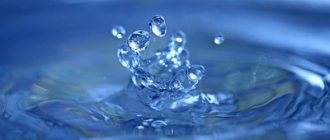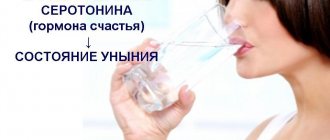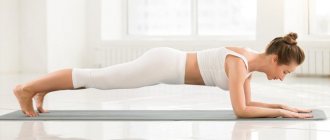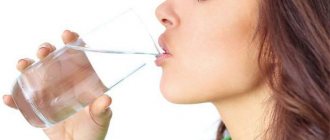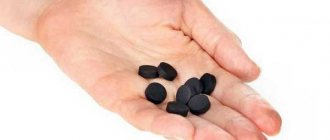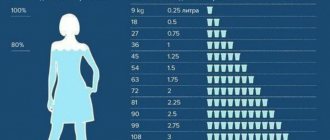The human body can live weeks without food, but only days without water. The body consists of 50-75 percent water. Water forms the basis of blood, digestive juices, urine and sweat, and is also found in muscles, fat and bones.
Since the body cannot store water, we need fresh food every day to compensate for the loss. The amount we need depends on our body size, metabolism, weather, the food we eat and our activity level.
Calorie content of ordinary water
Regular drinking water does not contain proteins, carbohydrates or fats, so it is not difficult to answer the question of how many calories are in 100 g of water. Its calorie content is 0 kcal! Our body receives about 1-1.5 liters of water along with solid food. In order for all its systems to function normally, the daily volume of moisture necessary for life must be at least 3 liters. An overweight person who decides to count calories and lose weight should additionally drink about 1.5-2 liters of clean water without calories during the day. In fact, this amount of fluid needs to be controlled, otherwise the body often confuses thirst with hunger. The process of weight loss with insufficient water intake is suspended.
This is due to the fact that our liver needs water to process fats. In a dehydrated body, the reaction of fat breakdown is slowed down. The level of consumption of pure water, mineral water (without gas) and green tea (without sugar), containing 0 (or an amount close to this figure) kilocalories, is usually reduced. It must be brought up to normal gradually. However, do not forget about regular physical activity, since increasing water consumption does not guarantee weight loss without exercise.
Recipes for dishes with oatmeal and water for diet
There are a variety of cooking methods that allow you to diversify your menu.
With apple and raisins
It only takes 30 minutes to prepare this breakfast. and ingredients such as:
- Hercules flakes - 100 g;
- apple (fresh) – 1 pc.;
- sugar – up to 30 g;
- water – up to 0.5 l;
- cloves – 3 pcs.;
- cinnamon – 5 g.
The cooking sequence consists of several steps:
- Cut the peeled apple into small pieces and add hot water (50 ml).
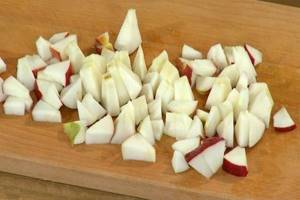
- Add cloves, cinnamon, sugar to the resulting mixture and place over medium heat. Stewing continues until the products soften, the liquid evaporates, and the spicy contents caramelize.
- In a separate bowl, add boiling water to the flakes and simmer over low heat for up to 20 minutes.
- Supplement the cooked porridge with prepared apples immediately before eating it.
Oatmeal with water, the calorie content of which needs to be increased without adding sugar, can be prepared by adding raisins. It will enrich it with fructose, lactose and other harmless substances. The peculiarity of this dish is that to preserve them, the oatmeal is not boiled, but steamed in raisin uzvar.
Only 3 components are used here:
- flakes – 50 g;
- water – 300 ml;
- raisins – 50-60 g.
Step-by-step preparation:
- Wash the raisins, pour boiling water over them, boil a little (up to 10 minutes) and remove from heat.
- Add cereal to this “semi-finished product”, cover the dish with a lid and wrap it up.
- After this steaming for 10-15 minutes. the finished dish is ready to eat.
With berries
This option is relevant at any time of the year, since you can use dried fruits, thawed/canned/fresh berries (bananas, apples, pears, raspberries, currants, blackberries, blueberries and others).

It is also attractive due to its ease of preparation, which consists of the following:
- boil water (400 ml);
- slowly add cereal/flakes (200 g) to the boiling water and cook until tender (20-25 minutes);
- season the “empty” porridge with sugar (2 tablespoons) and butter;
- When serving, the dish is supplemented with the available chopped berries.
With meat
This combination of the beneficial properties of oatmeal with meat rich in protein and fiber is the optimal solution for quickly preparing a diet dinner.
To prepare porridge with beef offal you will need:
- oatmeal – 300 g;
- water – 1 l;
- kidneys, heart, liver – 100 g each;
- onions, carrots - 1 pc. medium size;
- butter (butter or sunflower) – 3 tbsp. l.;
- salt - to taste.
Sequence of preparation:
- Pour water over the cereal, add salt and cook over low heat until thickened.
- Rinse the kidneys and peppers and then cook them in lightly salted water; when finished, cool and chop.
- Lightly fry finely chopped onions and carrots in a suitable type of oil, followed by adding chopped raw liver, and then a mixture of kidneys and heart. Cooking time – 10-15 minutes. over moderate heat. Combine cooked cereals with meat products in a shared bowl or individual utensils.
- Instead of these meat ingredients, you can use veal meat and chicken fillet. To do this, you need to finely chop them or grind them in a blender, boil them a little in salted water with a small amount of carrots, and then add them to the prepared porridge.
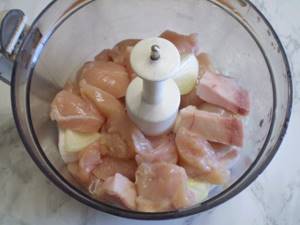
- After bringing the resulting mixture to a boil, turn off the heat and let it brew in a tightly covered container for 10-15 minutes.
With olive dressing
A savory seasoning for unsweetened oatmeal can be aromatic herbs (parsley, dill) combined with olive oil. To prepare it for 2 servings you will need butter (1 tbsp), chopped fresh herbs (small bunch) and garlic (1 clove), salt (to taste).
After combining the prepared ingredients, the resulting mass can be seasoned with porridges made from oatmeal or flakes.
With banana
To prepare porridge with bananas, experts recommend using whole oat grains rather than instant cereal. This makes it more saturated with carbohydrates (fast and slow) and energetically charged. For this reason, they are considered a real find for breakfast for people with increased physical activity.
Its peculiarity lies in the addition of the following ingredients to the porridge cooked in water:
- 1 PC. medium sized banana;
- 30 g brown sugar;
- a pinch of cinnamon;
- vegetable oil 1-2 tbsp. l.
The method of its preparation is to prepare them in parallel with the simmering of the boiling porridge. Banana cut into slices should be fried in butter along with sugar and cinnamon, and after caramelization, placed on the finished dish.
With prunes
This dried fruit allows you to diversify the nutritional qualities, taste and olfactory shades of oatmeal.
It is prepared this way:
- Soak prunes (about 100 g) in warm water for 30-40 minutes.
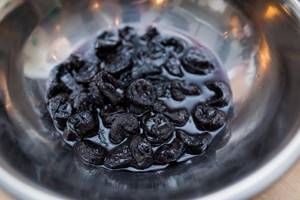
- At the same time, cook the porridge in sweetened water (20 g x 600 ml).
- Finely chop the prunes extracted from the liquid and mix with a small amount of melted butter (up to 50 g).
- Add the resulting mass to the porridge and mix carefully.
- Place all this for 10 minutes. into the oven to warm up at +130 °C. This will give the dish fragrant and juicy.
This type of porridge may include dried apricots and raisins that go well with prunes.
With strawberry
To prepare such a dish, you should add sugar to the porridge prepared according to the classic recipe along with strawberries, cut into slices of arbitrary sizes. You can add various spicy spices here (mint, cinnamon, vanillin, etc.).
In Scots
The peculiarity of this type of oatmeal porridge, called porridge in Scotland, is prepared only with water without adding salt, sugar, milk or butter. An important point is the use of crushed or whole oat grains, which, when cooked for half an hour over low heat, emit a delicate nutty aroma.

When eating ready-made, cooled porridge, seasoning in the form of salt, cream, and milk is allowed. In her homeland, the tradition of preparing porridge for a whole week is still preserved. Once a dense consistency is obtained, it can be cut into portioned pieces for breakfast.
In a slow cooker
This is the least expensive method, since a multicooker allows you to avoid overcooking, burning and wasting time while preparing porridge. A person must select the time of its readiness, the start option, add the necessary ingredients and navigate the ingredients-additions.
Next steps are as follows:
- Grease the bowl with 50 g butter.
- Pour 150 g of flakes into it and pour 400 ml of water.
- After adding sugar (20 g) and salt (5 g) to this mixture, stir.
- Cover, select the “Porridge” option and set the time (20 minutes). When storing food in the evening for breakfast, you should select the “Delayed Start” option.
- After the specified time has passed, add butter, fruits, berries, candied fruits, etc., and then continue for 5 minutes. to the “Heating” mode.
In a pot
The essence of this method is to fill the pots with cereal, water, sugar, salt, desired additions and thoroughly mix the contents. After this, place the container in the oven/microwave for 20 minutes, and then add the oil and selected ingredients (honey, fruits, meat products).
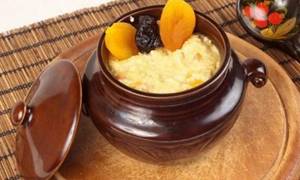
The porridge will be ready to eat after 10-15 minutes. its infusion in a covered pot with the oven turned off. Oatmeal prepared in any way can become the basis for such delicacies as: sour cream jellied pies, pancakes/cheesecakes/oatmeal cookies, muffins, bars.
At the same time, it remains possible to adjust their calorie content depending on their preparation in water or milk and the use of additional ingredients (yogurt, vegetables, fruits, candied fruits, cinnamon, chocolate, cocoa, nuts, seeds).
Article design: Ilchenko Oksana
For lovers of mineral water
Regardless of whether carbonated or still mineral water (without additives) relieves thirst, its calorie content is also minimal. The answer to the question of how many calories are in mineral water per 100 g of product, accordingly, will be the same: there are no calories in it.
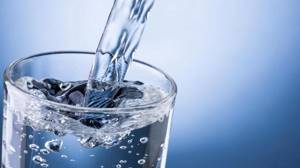
Therefore, nutritionists recommend drinking non-carbonated mineral water to everyone who is losing weight: table water can be drunk daily by a wide range of people, medicinal table water - only as an addition to a special dietary menu for the prevention and treatment of certain gastrointestinal diseases, obesity, diabetes and others. A carbonated drink is not suitable for those losing weight due to the carbon dioxide content, which delays the process of food processing and provokes increased gas formation and bloating.
Research
Although many studies have been done on food thermogenesis, which is how many calories the body needs to metabolize food, research has never shown a maximum calorie burn result.
More than 10 years ago, a German team of researchers decided to study 14 participants and found that when they consumed ice water, their calorie expenditure increased. According to the experiment, these expenditures were increased by approximately 30% per hour, resulting in the burning of 100 calories per day with two liters of cold water.
Cavani's Instagram post was considered racist, the footballer will miss 3 games
Amur mail: a cockatoo helped a guy make an unusual proposal to a girl (video)
How to make perfect popcorn at home in a frying pan: recipe
2 liters of cold water a day is quite a lot, but for 100 calories it is the least a person can do to lose them. Especially when you consider how much exercise you need to do to burn those same 100 calories.
Unfortunately, it was later discovered that the study's method of measuring calorie expenditure was flawed. There wasn't really a 30% increase in metabolic rate. There was only a very small statistical increase in calories burned.
How many calories are in sparkling water?
No additives - 0 calories! But if you mix one liter of mineral water with the juice of one lemon, one orange and add a pinch of sugar and salt, you will get a drink for hot weather that should be cooled.
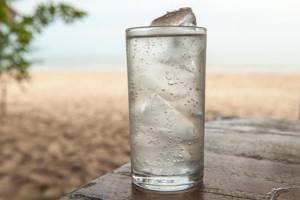
But its calorie content will consist of the total energy value of fruits, salt and sugar. Such calorie-rich lemonade is not suitable for losing weight.
Are calories burned?
Yes it is. The body will work to warm the cold water that a person drinks to its core temperature through the work of the metabolic system. This is similar to when an ice cube in a warm drink eventually takes on the temperature of the liquid around it and dissolves. And the drink gives up some of its energy to heat the ice. The body will use energy to heat the water, which must match the body's temperature. But how effective is this method of burning calories?

How many calories are in lemon water?
The energy value of lemon water depends on the method of its preparation. If you put a slice of lemon in a glass of water, then the calorie content of the drink due to a few drops of citrus juice in the water will be so negligible that it is also considered zero. A slice of lemon squeezed into a glass of water can increase the energy value of the drink by 22 kcal per 100 g of product. If you add lemon juice using a teaspoon, then you need to take into account that it holds 10 grams of product. This roughly corresponds to 2.2 kcal.
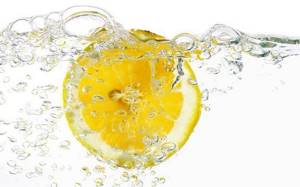
Knowing how many calories are in water (0 kcal), you can understand that this is exactly the amount a person losing weight will get from a glass of water with one teaspoon of lemon juice. Therefore, you can often hear from nutritionists that water with lemon juice not only quenches thirst well, but is also an excellent low-calorie drink for people trying to correct their body weight.
Benefits and harms
You should know what benefits or harms can come from eating oatmeal. Hercules porridge belongs to the group of “slow” carbohydrates. The concentration of vitamins and microelements in rolled oats is very high; it is very rare to find such a versatile useful product.
Contents and benefits of microelements and vitamins per 100 grams of dry rolled oats:
| Name | Content | Daily requirement % |
| E (tocopherol) | 3.4 mg | 23 |
| H (biotin) | 20 mcg | 40 |
| I (iodine) | 6 mcg | 4 |
| PP Groups | 4.6 mg | 23 |
| K (potassium) | 330 mg | 13 |
| Ca (calcium) | 52 mg | 6 |
| Mg (magnesium) | 130 mg | 32 |
| B1 | 0.45 mg | 30 |
| B2 | 0.1 mg | 6 |
| B5 | 0.90 mg | 19 |
| B6 | 0.24 mg | 12 |
| B9 | 23 mcg | 6 |
| Fe (iron) | 3.7 mg | 20 |
| Mn (manganese) | 3.83 mg | 191 |
| F (fluorine) | 45 mcg | 1 |
The benefits of regular consumption of rolled oats are undeniable. Oatmeal also contains essential microelements: chlorine, sulfur, choline, sodium, ash, silicon and many others. The benefits of rolled oats are simply off the scale, daily use will help: restore normal heart rhythm, improve condition after heart attacks, diabetes, rheumatism, colds, kidney or liver stones, cystitis, hypertension, nervous strain.
The antioxidants contained in cereals remove toxins and waste, and due to the high fiber content, intestinal motility improves.
Hercules improves lipid metabolism due to the content of polyphenols, which increases the fermentation (absorption) of nutrients. The great benefit for those who care about their beauty is that excess weight is reduced, and the skin becomes softer and cleaner. Oatmeal also has a diuretic effect.
Is there any harm from eating oatmeal? Indeed, teeth and bones can suffer from excessive consumption of oatmeal. It washes calcium out of the body, and the phytic acid contained in the cereal interferes with its absorption. But how much porridge do you need to eat?!

Rolled oats porridge will harm the body if you are intolerant to gluten, which is found in all cereals, especially oatmeal. Bloating and indigestion will be guaranteed. Also, the harm of frequent consumption of oatmeal is that due to the large amount of calories, especially fats and carbohydrates, it can cause excess weight.
Coffee, tea and sweet soda: what to choose?
Green tea without sugar contains only 1 calorie per 100 ml, black tea - 3-5, hibiscus (10 flowers) - 5, 1 tsp. Espresso or instant coffee - 2 calories. The caffeine content in black tea and coffee does not quench thirst, but only increases it. Therefore, nutritionists recommend a more “live” tea - green - to saturate the body with moisture. Remembering how many calories are in water, it is easy to calculate the calorie content of a cup of tea or coffee.
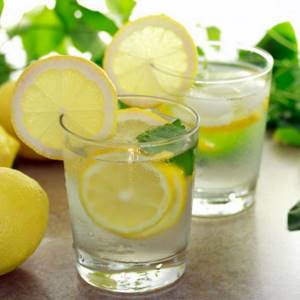
Sweet carbonated drinks owe their high calorie content to carbohydrates, which supply them with sugar: lemonades, Sprite, teas and Nestea drinks with various flavors contain 29-35 kcal per 100 ml of product, energy drinks - about 50 kcal (per 100 ml). For people losing weight, nutritionists consider it advisable to choose green tea without sugar and pure or mineral water without gas.
What kind of water is healthy and should you drink?
Liquids include fresh water and all other drinks such as milk, coffee, tea, soup, juice and even alcoholic beverages.
Fresh water is the best drink because it contains no kilojoules and provides the best hydration to the body.
Milk (especially low-fat milk) is an important liquid, especially for children, and contains about 90 percent water.
Tea can be an important source of fluid. Tea can help you meet your daily fluid recommendations and is a source of antioxidants and polyphenols that protect against heart disease and cancer.
Fresh fruit is preferred over fruit juice because it contains more fiber and nutrients and less sugar.
Avoid sweet and artificially sweetened drinks
Dietitians recommend limiting the consumption of drinks containing sugar, including sweetened teas, fruit drinks, vitamin waters, flavored mineral waters, energy drinks and sports drinks.
Consuming sugary drinks provides extra calories but not other essential nutrients. There is strong evidence of a link between the consumption of sugary drinks and excess weight gain in children and adults, as well as decreased bone strength and tooth decay.

Does cold water burn calories?
It is known that water contains no calories. Do they burn in the body when heating ice water? The answer is yes. But when calculating, you can see that the numbers are insignificant: to heat 500 ml of water from 0 degrees to body temperature, the body will burn only 17 kcal. Against the background of the required daily energy consumption of 400-600 kcal, this is not an enough amount for noticeable weight loss. Even the theory of drinking “8 glasses of water” every day will allow you to spend only 70 kcal on heating an ice-cold drink! At the same time, the chance of catching a cold will increase several times. Cold water is not approved by experts as a substitute for low-calorie nutrition and exercise.
The importance of water for humans
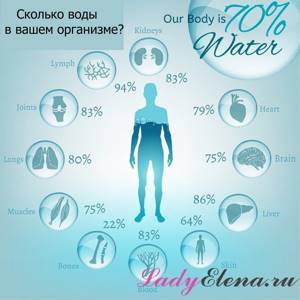
Water is needed for most body functions, including:
- Maintain the health and integrity of every cell in the body.
- Blood could move through the blood vessels.
- Help eliminate metabolic byproducts in the body, excess electrolytes (such as sodium and potassium) and urea, which is a waste product created when dietary protein is processed.
- Regulate body temperature by sweating.
- Moisten mucous membranes such as the lungs and mouth.
- Lubricate and restore joints.
- Reduce the risk of cystitis by keeping your bladder free of bacteria.
- Help digestion and prevent constipation.
- Moisturize your skin to maintain its texture and appearance.
- Transport nutrients and oxygen to cells.
- Serve as a shock absorber inside the eyes, spinal cord and in the amniotic sac surrounding the fetus during pregnancy.
Cleansing the body with water
With countless biochemical reactions occurring in the human body, a certain amount of toxic substances is formed, which the body must get rid of. The only possible way to get rid of toxins is to cleanse the body with water. After all, toxins are eliminated mainly through urine, sweat and feces, which also consists of 13-20% water.
With a lack of water, the concentration of all fluids in the body increases, which has extremely undesirable consequences. As blood concentration increases, its viscosity and coagulability increase, and the sugar and cholesterol content increases. Too concentrated blood can cause the development of cataracts, since thick blood is unable to penetrate the smallest capillaries of the eye tissues, and this leads to their death.
An increase in bile concentration is fraught with the development of cholelithiasis. A high concentration of urine can provoke the development of infections of the genitourinary system and lead to urolithiasis.
Effective cleansing of the body with water occurs when a person drinks so much liquid
that he feels the urge to urinate about 7-12 times a day.
If you follow an optimal drinking regime, it is possible not only to lose weight with water, but also to cleanse the body with water, as well as general health improvement.
Losing weight with water will be faster if you review your nutrition system and increase energy consumption through physical activity.
We found out how many calories are in water: the calorie content of water is zero. Therefore, when losing weight, it would be reasonable to include in your diet foods and dishes that contain a large percentage of water (remember, the calorie content of water is zero). These are, first of all, berries, fruits and vegetables. In addition, when dieting, one should not forget about liquid dishes - soups. Vegetable puree soups are especially useful. Both fruits and vegetables and puree soups contain a small amount of calories, but due to their significant volume and high fiber content they provide a feeling of fullness for a long time. By including these products in the menu, you will provide the body with a sufficient amount of fluid, making water work for weight loss
.
Optimal water consumption maintains metabolic processes at a fairly high level. But moderate physical activity will help to further activate your metabolism and increase energy expenditure. For example, vigorous walking, skiing, cycling. Physical activity will require an increase in water consumption, which means that the body will be cleansed more effectively with water, cell renewal processes will be more intense, and it will be possible to maintain youth longer.
Water is a useful and vital product. It always takes first place in the daily diet. Drinking clean water is necessary to maintain all body systems. According to its composition, it is divided into mineral, table and medicinal.
Other types of liquid
Today in any store you can find a huge variety of drinks:
- based on spring water;
- carbonated;
The presence of gas and where the liquid is taken from does not increase its energy value. How many calories are in mineral water? The quantity is the same as in the usual one, equal to zero. But other supplements can increase this figure. For example, if you squeeze half a lemon into a glass, it will already contain calories. Not very much, but these numbers are important for those who are calculating the value of their diet. So, 100 g of lemon juice contains 16 kcal. Therefore, a teaspoon contains very few calories, but if you add sugar or syrup, the drink will “weigh” much more.
It’s not for nothing that those who are losing weight are contraindicated to drink sweet soda.
- it contains a lot of so-called “empty” calories, which are not spent by the body, but go straight into fat deposits. Therefore, everyone who is forced to monitor their weight should forget about lemonade, cola, ready-made bottled tea - there are also many additives that do not benefit health (flavors, dyes, etc.).
Another common drink is tea. Without additives, it contains so few calories that they can be ignored. But each teaspoon contains 5 g of sugar - that’s 20 calories, if “heaped”, then 8 kcal more. Many people do not limit themselves to one spoon, they add 3-4, drinking several glasses of tea a day. And this already turns out to be a noticeable amount, comparable to a snack. If you add milk or syrup, the energy value will increase.
When stopping to grab a bite to eat at a cafe, you should also be careful about the choice of drinks. For example, a small portion of latte contains about 150 Kcal, and a large one - almost 300. If you eat this with a piece of cake (a standard piece of 150 grams is 350-400 Kcal), you will get half the daily requirement (with a sedentary lifestyle it is 1200 Kcal). Therefore, while burning excess fat, you should forget about gatherings in your favorite cafes. Or limit yourself to just a drink, without filling it with sweets, and be sure to include your snack in your food diary.
How to increase your water consumption
- Add lemon or lime juice to plain water for added variety.
- Keep a bottle or glass of water nearby on your desk or in your bag.
- Add fresh fruit ice cubes to a glass of water.
Limit your consumption of mineral water
Commercial bottled mineral water contains salt, which can lead to fluid retention and swelling, and even high blood pressure. Limit the amount of mineral water or choose low-sodium varieties (less than 30 mg sodium per 100 ml).
- Author: Maria Sukhorukikh
Rate this article:
- 5
- 4
- 3
- 2
- 1
(1 vote, average: 5 out of 5)
Share with your friends!
Chlorination!
Yes! Bleach causes great harm. So huge that words cannot express it. By the way, water began to be chlorinated in 1904. Like, in order to disinfect it. No one knew then what danger awaited later.
Two dangers of bleach:
- Chlorine penetrates the skin.
- Chlorine passes through the nasopharynx.
Chlorine is the cause of many different diseases and problems:
- Heart disease.
- Atherosclerosis.
- Increased pressure.
- Anemia.
- Destruction of the hair structure.
- Drying of the skin.
- Irritation of the ocular membrane of the eye.
- Hair loss.
- Hair becomes oily.
- Hair becomes brittle.
